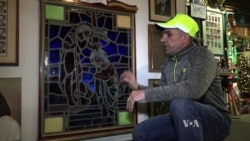New York City’s sanitation workers pick up more than 12,000 tons of refuse and recyclables every single collection day. And, through the efforts of one man with a dream, the Sanitation Department has its own museum-like collection of trash — that has become what he calls a "treasure."
Nelson Molina — who worked 34 years with the New York City Department of Sanitation — is the curator of collection.
"In New York City, people throw everything out,” he said. “So, you give me three months, I probably could furnish a two-bedroom apartment. You know, all the stuff that's out there, living rooms, bedrooms, kitchen, bathrooms, everything. It's out there."
Stored in the nondescript East Harlem Sanitation garage, the collection includes at least four Mona Lisas, thousands of pieces of furniture, vintage glassware, an African art collection, paintings and posters, and an extensive Christmas display.
Favorite finds
But, among all that, Molina has his favorites.
"This is the Star of David,” he said, lifting the glass cover off a metal star and reading the attached plaque. “ ’In memory of 9-11, created from the steel of the World Trade Center.’ This was found in the garbage."
Another great find: the stained glass windows from a 120-year-old church that Molina picked up from the street.
Anthropologist Robin Nagle says the entire collection provides an insight into the American lifestyle.
"Part of the magic of this collection is how rich it is in detail about the contemporary past of our society, of our city of New York, of American life, going back decades but also very much of the moment,” Nagle said. "Think about how archaeologists look at relics and artifacts from ancient civilizations to read the details of the lives of the people who left that behind. You can do the exact same thing with household trash left on the curb today."
Molina's days of picking up trash are over.
Just retired, he's a caretaker of his realm, checking out the collection two or three days a week. It took decades of work and care — and what Molina calls his “internal alarm bell,” that goes off when there's something worthwhile in that trash bag.
And, one day, those treasures might be available for the public to peruse — if a proposed Sanitation Department museum is built.








